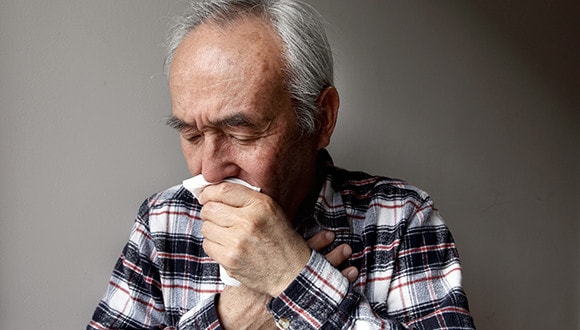Lung cancer: the facts
Learn more about the biggest cancer killer in Australia.
Gina Flaxman
June 2019
In 2015, Virginia Wilson, then 48, had a persistent cough, was often hoarse and breathless and her shoulder ached.
“My doctor said I had asthma and I was on a puffer.”
Eventually, Wilson asked for a chest X-ray. A follow-up CT scan and lung biopsy confirmed she had lung cancer. Just 3 weeks after being diagnosed, she had the top part of her right lung removed.
“It was only stage 1,” she says. “There was no cancer in the lymph node and surrounding tissue. This is my 4th year of being given the all clear.”
Unfortunately, that’s not the case for many people with lung cancer. It’s the biggest cancer killer in Australia. More than 9,000 people died of the disease in 2018, estimates the Australian Institute of Health and Welfare.
“Lung cancer also has the lowest 5-year survival rate – just 17% – of the most commonly diagnosed cancers in Australia,” says Louise Underhill, a lung cancer support nurse at the Lung Foundation Australia.
This is because many people are diagnosed really late. “Lung cancer symptoms can be vague,” says Underhill. “Because of this, almost 85% of Australians are diagnosed at stage 3 or 4.”

What is lung cancer?
Like other cancers, lung cancer is the result of uncontrolled growth of cells that, over time, develop into a large mass or tumour. There are 2 main types of lung cancer: non-small cell lung cancer and small cell lung cancer, which are usually treated differently. Non-small cell lung cancer is the most common and accounts for about 80% of diagnoses.
The disease has 4 stages: in the first, the abnormal cells are confined to the lung. In stage 2, the cancer has spread to nearby lymph nodes or the lining of the lungs. In stage 3, it has spread to other areas within the chest cavity. In stage 4, the cells have spread beyond the lung and chest to other parts of the body.
In addition to the symptoms Wilson experienced, symptoms can include fatigue, chest pain, unexplained weight loss, recurring bronchitis or pneumonia and coughing up blood.
For stage 1 non-small cell lung cancer, surgery is usually the first treatment option. Chemotherapy, immunotherapy and radiotherapy can also be used at different stages. Underhill says 1 or more treatments may be used depending on the type of tumour, the stage of the disease and the patient’s overall health.
New targeted therapies can be effective for some patients, and are designed to attack cancer cells without harming healthy cells. Cancer Council says it’s likely that new types of targeted therapies will continue to be discovered.
Not just a smoker’s disease
While tobacco smoking is the biggest cause of lung cancer, Professor Sanchia Aranda, Cancer Council Australia CEO, says 1 in 5 cases are not related to smoking. She says there needs to be more attention paid to environmental causes such as pollution and occupational exposure to silica and diesel. Asbestos exposure is still an issue, too. Genetics and family history are also risk factors.
“There is a significant amount of stigma associated with lung cancer diagnosis,” says Prof Aranda. She says this contributes to delays in diagnosis.
Wilson, an ex-smoker who also has a family history of the disease, agrees. “There’s an incredible stigma. I didn’t want to tell my kids; I felt I’d let them down.”
Four years on, Wilson, who has 4 children and 1 grandchild, says her lung function is back to normal and she has become active in the lung cancer network, helping to raise awareness of the disease and campaigning for a national early screening program.
“I’m so lucky and grateful. Now I want to help others, reduce the stigma and save lives. Cancer doesn’t discriminate, so neither should we.”
Related articles
WHEN GAMING TECH HELPS CANCER PATIENTS
A cutting edge virtual reality project is helping patients better understand cancer cells.
SHEDDING A LIGHT ON LESSER KNOWN CANCERS
They’re sometimes called “the forgotten cancers” but they should be talked about. We uncover the facts about rare cancers and a study aiming to better understand them.
HOW AIR POLLUTION AFFECTS US, AND HOW TO REDUCE IT
As our cities grow, town planners look for ways to improve air quality and limit respiratory problems caused by pollution.
WHAT IS CHEMOTHERAPY?
Chemotherapy is a common cancer treatment: we explain what it involves and the different forms it can take.